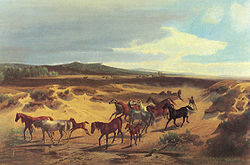 In the Moosheide nature reserve, 2016 | |
| Conservation status | |
|---|---|
| Other names |
|
| Country of origin | Germany |
| Standard | [https://web.archive.org/web/20250809183455/https://www.senner.de/Zuchtprogramm%20Senner,%20incl.Anlage%20%20Stand%2010.11.2018.pdf |
| Use | |
| Traits | |
| Weight |
|
| Height | |
| Colour | any |


The Senner or Senne is an endangered German breed of riding horse. It is believed to be the oldest saddle-horse breed in Germany, and is documented at least as far back as 1160. [5] [6] It is named for the Senne, a natural region of dunes and moorland in Nordrhein-Westfalen, in western Germany, and lived in feral herds there and in the Teutoburger Forest to the east.
Contents
It is a warmblood, and has been influenced at various times by Arab, Anglo-Arab, Thoroughbred and Iberian stock. [4] : 502 It may have contributed to development of the Hanoverian. [7] : 186